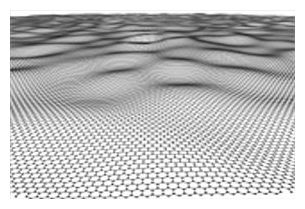
The new discovery reported in the journal Nature raises the possibility that graphene membranes could one day be used to "sieve" hydrogen gas directly from the atmosphere to generate electricity.
"We are very excited about this result because it opens a whole new area of promising applications for graphene in clean energy harvesting and hydrogen-based technologies," says study co-author Marcelo Lozada-Hidalgo of Manchester University.
Graphene was first isolated in 2004 by the leader of this study, Professor Andre Geim who, with fellow researchers was awarded a Nobel Prize in 2010 for the work.
At just one atom thick graphene is renowned for being the thinnest material on Earth.
It is 200 times stronger than steel, and impermeable to all gases and liquids, giving it the potential for a range of uses such as corrosion-proof coatings, impermeable packaging and even super-thin condoms.
Surprise discovery
Knowing that graphene is impermeable to even the smallest of atoms, hydrogen, the research team decided to test whether protons, hydrogen atoms stripped of their electrons, were also repelled.
Against expectations, they found the protons could pass through the ultra-strong material fairly easily, especially at raised temperatures and if the graphene films were covered with nanoparticles such as platinum, which acted as a catalyst.
Geim and Lozada-Hidalgo, say the findings mean graphene could in future be used in proton-conducting membranes, a crucial component of fuel cell technology.
Fuel cells, used in some modern cars, react oxygen and hydrogen fuel together, converting chemical energy into electricity and producing only water.
But a major problem is that the fuels leak across the existing proton membranes, "poisoning" the process and reducing the cells' efficiency - something Geim says could be overcome with graphene.
The team also found that graphene membranes could be used to extract hydrogen from the atmosphere, suggesting the possibility of combining them with fuel cells to make mobile electric generators powered by nothing more than the tiny amounts of hydrogen in the air.
"Essentially, you pump your fuel from the atmosphere and get electricity out of it," says Geim.
"Our (study) provides proof that this kind of device is possible."
Source: Reuters



will remain unused until a way is found to make it usable by the general populace thru a prioitized distrubution system.